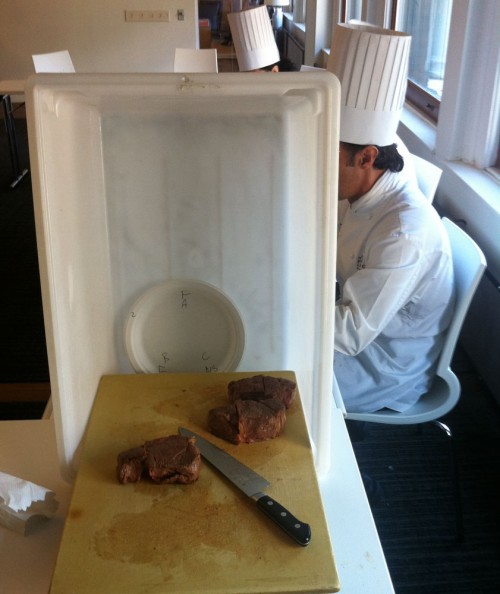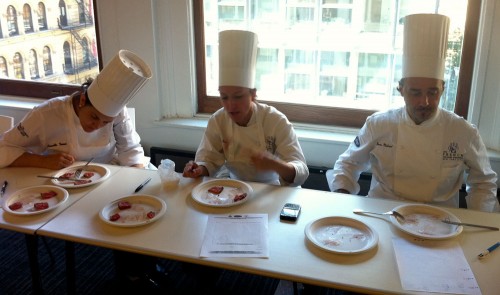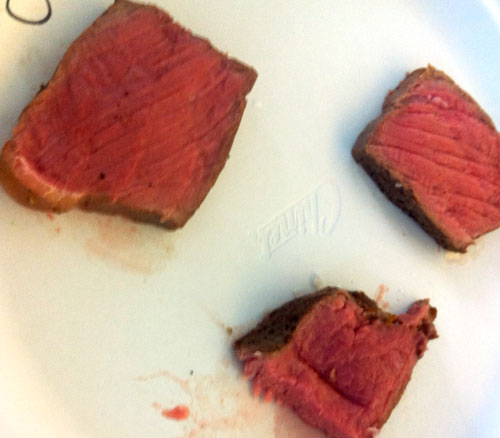by Dave Arnold
Should you salt meat before you sear it? I thought the answer was always yes. But the answer is: it depends.

My Previous Position:
Some cooks don’t like to salt before they sear because, they say, salted meat loses juices. But who cares? Losing juice does not mean the meat won’t be juicy. Extra juice makes meat taste watery and bland. Moisture isn’t necessarily your friend; delicious is your friend –and salting meat before you sear it makes it more delicious.
My Position Changes:
I have found an exception to my salt-before-searing rule that should have been obvious to me –low-temperature cook-chill meats. With low temperature cooking you use very precisely controlled temperatures to cook to exact levels of doneness. If I want a medium-rare steak with an internal temperature of 55â°C (131â°F) I cook it in butter at exactly 55â°C, not in an oven or pan at 200â°C (392â°F). Wanna know more about low-temp cooking and all its advantages? See my unfinished primer here.
There are two main types of low-temperature cooking –direct-serve and cook-chill. For direct-serve you cook foods and serve them right away. For cook-chill, foods are cooked, chilled, stored, and rethermalized* at service time. Here is a typical sequence for cooking a steak:
- Sear the raw rib-eye. This step kills bacteria on the surface, starts the browning reactions that contribute to good meat flavors, and ensures that a nice crust will be formed quickly later when the meat is seared again.
- Put meat in a bag with butter.
- Cook the steak for 1-4 hours at 55 C. The optimum length of time depends on how tough the particular steak is.
- Now, either:
- Pull the steak out of the bag, sear it (to make a nice crust) and serve it. This is Direct Serve.
Or:
-
- Chill the meat and store.
- Retherm it at 52 C.
- Pull the steak out of the bag, sear it and serve it. This is Cook-Chill.
My direct-serve meat has always been delicious, but I had noticed that my cook-chill meats were never quite as juicy and delicious, and the color was a little strange. I thought about the fact that I always liberally salt my meat before I cook it, and came to believe that salt might be the culprit. Maybe the pre-sear salting was curing the stored meat even though it was cooked –rendering it firmer and less juicy.
To check the theory I ran a test, cooking rib-eyes three different ways:
- A rib-eye was salted, seared, placed in a vacuum bag, and cooked at 55 C for 1.5 hours, chilled, stored for two days, rethermed at 52C for one hour, seared, and served (Salted Cook-Chill).
- A rib-eye was seared without salting, placed in a vacuum bag, cooked at 55 C for 1.5 hours, chilled, stored for two days, rethermed at 52C for one hour, seared, salted, and served (Unsalted Cook-Chill).
- A rib-eye was salted, seared, placed in a vacuum bag, and cooked at 55 C for 1.5 hours, dropped to 52 C and held for one hour, seared, and served (Salted Direct-Serve).
You’ll note I salted the unsalted meat before service, because if I didn’t, it would be too easy for my tasters to distinguish.
I called in a three-person tasting panel (our Chef Hervé (who did the actual cooking on this one), Chef Annette, and Chef Angela).

We used a triangle-taste-test protocol. In a triangle test, I serve two pieces of meat that have been prepared the same way, and one that is different, and see if the panelists can detect the one that is different.

Results:
The panel easily and unanimously correctly distinguished between the salted and unsalted cook-chill meats. As expected, the salted meats were firmer, and had a more cured color than the unsalted. Everyone preferred the unsalted meat. The panelists were also all able to distinguish between the salted direct-serve meat and the unsalted cook-chill. Here, the panelists also preferred the unsalted cook chill, because the direct-serve steak, although juicier than the cook-chill steak, had a stringier texture. The differences between these two steaks were not as stark as with the salted and unsalted cook-chill meats. In my opinion, the differences between these two could simply be due to inter-steak variation. More tests are in order.
The Upshot:
If you are serving your meats within a couple of hours, salt before you sear –it’ll be great. If your service is many hours or days away, lay off the salt till service time.
*I use rethermalize instead of reheat not because I like useless fancy words, but because the food code requires very high temperatures for “reheating,†but has no standards for “rethermalizing.†Dumb but true.

I thought I blundered on to this same result and so I am glad you tested. Thank you.
Also, I am soooo glad to see tests using proper methodology like the triangle test. Drives me nuts to see taste testing methods (even blind) which reveal nothing.
A.
I wonder how a fourth option would do. I recently noticed the same issue with my salted and rethermed proteins, so I started salting before the final searing step.
This is a slight difference and I haven’t done any seriously structured testing, but in my unscientific experience I prefer the seared, bagged/cooked, salted then seared product over the seared then salted product.
Using your format above it would look like this:
A rib-eye was seared without salting, placed in a vacuum bag, cooked at 55 C for 1.5 hours, chilled, stored for two days, rethermed at 52C for one hour, salted, seared, and served (Unsalted Cook-Chill).
Do you have any thoughts on this ordering?
Sounds like a good procedure to me Andrew.
Joan Roca salts fish by soaking it in a 10% brine for 4 mins (http://www.youtube.com/watch?v=pGY0HO61Vzo head to 38:45).
Would this work for meats too?
Hello Andres,
Salting fish before a low-temp cook does several things:
1. It seasons it,
2. It prevents ugly white protein blobs from coming to the surface of the fish and marring the appearance.
3. It firms the fish by partially curing it.
Numbers 2 and 3 are important for low temp fish because super-low temp fish needs some firming and because low temp fish with coagulated albumen at the surface looks disgusting. You can salt meat this way (although many cooks wince a the idea of putting expensive cuts in any sort of liquid), but it won’t prevent the meat from taking on a partially cured texture when stored for a long period of time. I suppose if the added salt level was low enough you might get away with it, but then the seasoning effect wouldn’t be as great either.
Hi Dave – Thanks for the insight!
It looks like the guys over Ideas in Food (http://blog.ideasinfood.com/ideas_in_food/2011/10/corrective-seasoning.html) did also try the salting by brining approach but they still prefer the searing after cooking approach.
Yay triangle test! I’m glad you’re getting some use out of Heymann & Lawless. I wonder if to control for inter-steak variation, using six steaks (two for each cooking method/treatment). So if A is salted cook-chill, B is Unsalted cook-chill, C is salted direct-serve, you use steaks A1, A2, and B1 in the test to distinguish between salted and unsalted cook-chill, rather than A1, A1, and B1 as you did here. And then see how the results of the two panels compare to each other. Though it’s not a strict triangle test if the two “identical” sample are not technically identical, it could be a powerful (in the stats sense, I suppose) way to see if cooking method/treatment variation is a stronger effect than steak-to-steak variation. Heymann did a bunch of meat sensory evaluation at Missouri before she came to Davis so there might be some useful pointers in her earlier literature.
awesome post!
great post and timely.
Thanks Alex.
Very interesting…do the same factors apply when braising? Braising is somewhat the same principle as cook-chill.
Yes Tommy,
In a traditional braise, the meat is so cooked to heck that comparisons are hard to make (the moisture in the braise coming from rendered collagen). In low-temp braises, however, the effect is quite apparent. We made a 48 hour short rib in a bag with no salt and it came out tasting like a steak.
I was going to ask about that. I cook beef short ribs at 55C for 48 hours and sometimes they come out with a flavor reminiscent dry-aged beef. Now I think it might be that I usually brine the ribs in a 1% salt solution, sear, then bag and circulate.
Incidentally, you’re one of my heroes. 🙂 I love the science of cooking and knowing why stuff does what it does and this is one of the few places where I can get that kind of information.
Thanks!
Hi Dave,
I wonder why you salt the “Unsalted Cook-Chill” steak right before serving? Wouln´t it be better to salt it before the second sear?
Hannes
Good point Schinderhannes,
Next time I’ll try that. The hard part to control for is overall saltiness.
Good to hear from you.
Instead of butter in the bag, try a little bit of the jus or sauce that you will be serving with it…i find it gives it more of the roasted flavor that sous vide meat is lacking.
Chinet ftw! 🙂
Hello Dave, have you ever looked into testing Aw levels for something like this?
Hello Michael,
Alas I don’t have an easy way to measure Aw. I once tried to rig a ghetto Aw meter, but didn’t have any luck. Suggestions appreciated.
Great article. I dont’t like too much salt in my dishes, but my husband likes it a lot. Thanks for the text, which was a pleasure to read..
Hi Chef Arnold!
I’m not sure if you remember me, a globalized Korean (FCI graduate, class of 2010 December) who was amazed with your liquid nitrogen pu’er tea cocktail at the Lucky Rice night market. I recently moved to Beijing and now planning to start my own food blog/online cooking show here… I just wanted to say, I’m a BIG fan of your blog! Your Salt or Unsalt entry as well as your previous entry where you compared hundreds of pears (?) are two of my favorites. On my recent trip to HongKong, I went to a popular molecular bar where the bartender was using centrifuge and other fancy equipments to make the drinks (earl gray caviar martini)… I spoke with the owner there and he also told me he’s a big fan of yours, in fact, he told me he learned a few techniques from you! 🙂 Please keep writing, you have fans all over the world!
thanks for inspiring me with food science,
TJ-
Hi Chef Arnold!
I’m not sure if you remember me, a globalized Korean (FCI graduate, class of 2010 December) who was amazed with your liquid nitrogen pu’er tea cocktail at the Lucky Rice night market. I recently moved to Beijing and now planning to start my own food blog/online cooking show here… I just wanted to say, I’m a BIG fan of your blog! Your Salt or Unsalt entry as well as your previous entry where you compared hundreds of pears (?) are two of my favorites. On my recent trip to HongKong, I went to a popular molecular bar where the bartender was using centrifuge and other fancy equipments to make the drinks (earl gray caviar martini)… I spoke with the owner there and he also told me he’s a big fan of yours, in fact, he told me he learned a few techniques from you! 🙂 Please keep writing, you have fans all over the world!
thank you!!
TJ
[WORDPRESS HASHCASH] The poster sent us ‘0 which is not a hashcash value.